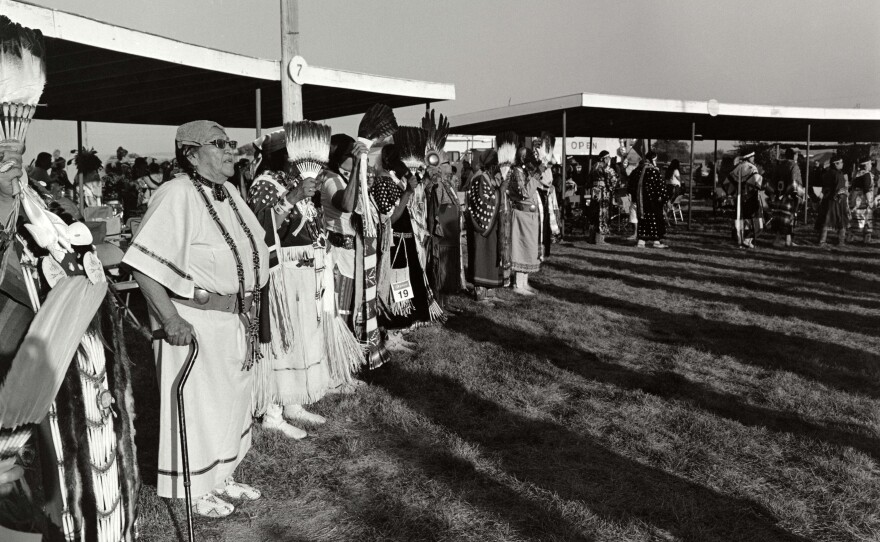Lander writer and photographer Sara Wiles has been spending time with families on the Wind River Reservation, and taking their pictures, since she started a job as a social worker there in the 1970's. Her latest book, The Arapaho Way: Continuity and Change on the Wind River Reservation, is a culmination of those 40 plus year relationships. Through essays and photographs, it documents the contemporary history of the Wind River.
Wyoming Public Radio's tribal affairs reporter Savannah Maher sat down with Wiles to talk about the book, which is out this week.
Savannah Maher: Are there photos in the book that you're most proud of, that you like the most?
Sara Wiles: Gee, it's like picking out your favorite grandkid, you know? I do have one here I really like. This is Nora Oldman, during the grand entry at a Powwow. Just before sundown, bright sun. And I like this picture because she's got a washcloth on her head. So everyone else here is dressed fancy and she's dressed in a real plain traditional dress with a washrag on her head. And these here are documentary pictures. In 2015, two Arapaho men were shot in Riverton. Have you heard that story?
SM: Yeah, I have. Especially in light of the [police] shooting that just happened in Riverton, it's something that has come up quite a bit.
SW: Good, I'm glad that people are still remembering that. A couple of weeks after the shooting, an Arapaho man named Ron Howard, and others, too, organized a peace march in Riverton because tensions were running high. And then one of the men who was shot in Riverton survived. His name is James Goggles Jr., known as Sonny. So there's pictures [in the book] of Sonny when he came back to the Reservation. He was in the Veteran's Administration hospital in Sheridan for quite a while, and they brought him back about a year after the shooting for an honoring ceremony and a dinner. He had to have help walking because there's a bullet in his head. And so he has trouble in several ways, and one of those is walking steadily. So all of that is in the book, so I'm hoping that'll be good documentation.
SM: I think that's something that people here really value. Because one of the complaints that I hear about photography of Native people and writing about Native people is that there's quite a bit of interest in history, things that happened 100 years ago or more —
SW: Oh yeah, not the day-to-day stuff and the hard stuff.
SM: Exactly, yeah, and that's a lot of these photos in your book.
SW: Right, yeah. And stuff happens. You know, bad stuff happens, and of course good stuff happens too.
SM: It's of great interest to me as someone who's not from here and trying to document certain parts of life on Wind River how you reached the point with these families where they were willing to have you photograph them and willing to share these stories with you.
SW: Well it was a long process. Just taking a few pictures here and there, you know usually of people I knew well. The one thing I did from the very beginning was always give lots of copies to people. Because there's this idea that people come to take. You know they come to take picture and then they're taking it away and that's the last you know about it.
SM: Over the years, have you ever had any pushback? Anyone who said that a white woman is not the right person to be documenting these things?
SW: I think again, I'd been here so long and it was such a gradual process. By the time it got to the point of having the books, people were real used to me. So I was really careful. And I'm sure there's people out there who gripe about it. You know, anything you do in any community somebody's going to complain about it. But I haven't had a lot of that type of feedback.
SM: In these photos and your writing, you can really feel the intimacy that you have with these families. I think rural communities, and rural Native communities especially have this reputation for being sort of insular and difficult to enter as an outsider. But I think the flip side of that is evident in your book, that once you build that trust and make yourself a part of the community, it's a community and an acceptance like nothing else.
SW: It's real hard for me to articulate that, because it's just been my life for so long. I know more people on the Reservation and am engaged with more activities and events on the Reservation than I am in Lander, where I live. For years and years, I had people in Lander ask me, "Why do you want to do that? Why do you want to go out there? Is it safe for you to go out there?" And I stopped trying to answer those questions and be around a lot of those people because I just don't want to deal with that attitude. Anyway, it's an odd life I've had.
SM: Well, thank you so much for taking some time to talk with me about it.
SW: Yeah, well thank you for coming over.









